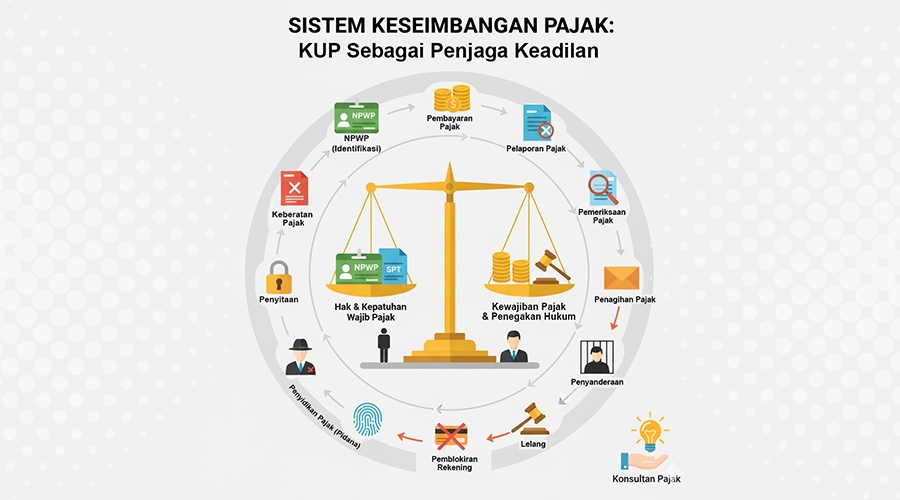
The Law on General Provisions and Tax Procedures (UU KUP), originally Law No. 6 of 1983 and its subsequent amendments (most recently Law No. 7 of 2021 on Harmonization of Tax Regulations or HPP), is the law that governs the legal relationship between a taxpayer and the government (in this case, the Directorate General of Taxes/DGT).
It is essentially the "bible" of tax administration, outlining the rights and obligations of taxpayers as well as the authority of the DGT. The primary goal of the KUP is to create a tax system that is simple, fair, transparent, and accountable.
Key Principles of the KUP:
The Self-Assessment System:
This is the core principle of Indonesia's tax system. Taxpayers are entrusted to calculate, pay, and report their own tax liabilities.
The DGT no longer calculates the tax for every taxpayer; instead, it acts as a supervisor to ensure compliance.
Taxpayer Identification Number (NPWP):
The NPWP is the mandatory identification number for every individual or entity that meets the requirements to be a taxpayer.
It is used for all tax administration purposes, from payments and reporting to the issuance of tax invoices.
Tax Return (SPT):
An SPT is the report used by taxpayers to declare their calculation and/or payment of taxes, either for themselves or for others.
There are two main types: the Annual Tax Return (to report taxes for one year) and the Periodic Tax Return (to report monthly taxes, such as VAT and Income Tax Article 21).
Sanctions and Penalties:
The KUP establishes various sanctions, including administrative penalties (fines, interest, increases) and criminal penalties, to encourage taxpayer compliance.
Examples include fines for late filing of SPTs, interest on underpaid taxes, and penalties if unreported data is discovered.
Tax collection is a series of actions taken by the DGT to enforce the payment of a taxpayer's outstanding tax debt, which includes administrative sanctions such as interest, fines, or increases. This process begins when the DGT finds an unpaid tax debt after its due date.
Tax Collection Documents:
The tax collection process has clear, legally regulated stages. Here is the sequence of documents issued during the collection process:
Tax Warning Letter:
This is the DGT's first warning, sent after the tax payment due date has passed.
This letter gives the taxpayer 21 days to settle their tax debt.
Distress Warrant:
If the taxpayer does not respond to the Tax Warning Letter, the DGT will issue a Distress Warrant (Surat Paksa).
This is an official order from the state to the taxpayer to immediately pay their tax debt. This document has the same executive power as a court ruling.
With the issuance of a Distress Warrant, the DGT has the right to initiate active collection measures.
Active Collection Actions:
If the tax debt is still not settled after the Distress Warrant, the DGT can take various active collection actions, including:
Seizure: The DGT can seize the taxpayer's assets, both movable (vehicles, jewelry) and immovable (land, buildings), which can then be sold at auction.
Coercive Custody (Gijzeling):
This is the most extreme collection measure. A taxpayer with an outstanding tax debt of more than Rp100 million and a doubtful commitment to pay can be placed in a correctional facility for a maximum of six months (which can be extended).
This action is only taken after a series of legal procedures and with the approval of the Minister of Finance or a designated official.
Auction: After the assets have been seized, a tax bailiff will conduct an auction to sell them and use the proceeds to pay off the tax debt.
Account Blocking: The DGT can request that banks block the taxpayer's bank accounts.
As consultants, we strongly advise taxpayers to always comply with their tax obligations, from calculation and payment to reporting. Understanding the KUP and tax collection process is crucial to avoid sanctions and legal issues in the future.